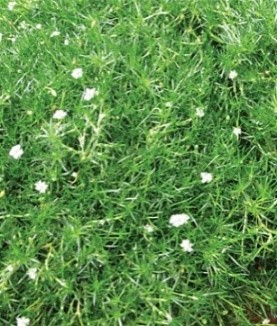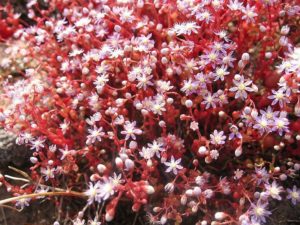Chamomile has been valued since ancient times for its many beneficial properties and delicate scent (the name comes from ancient Greek, meaning ‘ground apple’).
There are different types of chamomile but one, Chamaemelum nobile treneague – Roman chamomile, aka lawn chamomile, is an evergreen that grows 2 to 4 inches in height.
Treneague means nonflowering and is also the name of the English estate where this low-growing lawn was first cultivated. It is produced by using rosettes which are propagated from the adult plant as it sends out shoots to start new plants. The result is a thick mat of dense leaves that gives a smooth, manicured appearance.
Planting the seeds of Roman chamomile will produce a less dense mat that will produce pretty little white flowers. These waves of tiny little leaves and flowers can be pretty or pretty creepy, depending on the number of alien-vegetation-attacks movies you’ve seen. “Look out John! Behind you! Ahhhggghhh!-“ ahem. Sorry…
A blanket of chamomile on hard-to-manage areas such a meadows or slopes can be a cost- and time-saving practical solution. Artful geometric arrangements within a landscape of grass, other ground covers and stones is a favored choice of many gardeners.
A wide swath can trace the borders along paths, curbs and retaining walls. Smaller portions can be strategically placed in rock gardens or whimsically laid as the seat cushion of a garden bench.

Benefits of a chamomile lawn
Reduces/eliminates mowing. Although it can be lightly mowed, chamomile really only requires a Spring fertilizing, weeding, and minimal foot traffic to really shine. Think of the reduction in noise pollution, gas and oil fumes, or the cost of powering that electric mower!
Easy solution for hard-to-manage areas. Imagine that troublesome eroding slope blanketed in green. Your back will thank you for ending the crouch-to-dodge-the-tree-branches approach to mowing. A mat of chamomile could make artful rings around those trees.
Soil enricher. A good source of nitrogen.
Drought resistant. Laugh at dry spells, your carpet will stay green.
Inexpensive to start and manage – 50 plants set 6 inches apart will cover nearly 11 square feet. The closer the plants are placed, the faster full coverage will occur.
CAUTIONS
Roman Chamomile is in the ragweed family (the Asteraceae or Compositae family also includes marigold, daisy, and asters). As such, it could cause contact dermatitis.
Although some holistic sources say that the essential oil is beneficial to dogs, chamomile is on the list of plants that are toxic to dogs, cats, and horses from the American Society for the Prevention of Cruelty to Animals (ASPCA).
If you aren’t sure, consult a professional. Or simply apply the maxim “better safe than sorry” and keep your pets away.
GROWING A CHAMOMILE LAWN
HGTV suggests planting in early fall or early spring. The latter will enable you to enjoy your chamomile carpet later the same year. This living carpet thrives in light, free-draining soils such as sandy loam.
Avoid heavy clay-type soils. It thrives in full sun but can take a little shade; if planting around a tree, the light coming through the leaves should reach the ground.
It is not much of a competitor so thorough weeding should be done before planting.
Stepables.com was the first U.S. source that I found for obtaining the Treneague plant. They don’t sell it online but do provide a search locator to find authorized dealers nationwide. Dave’s Garden also provides a list of U.S. sources and helpfully provides shoppers’ reviews for each.
The site also maintains a trade list. Of course, there are many nurseries in the U.K. that sell the plants and seeds but I didn’t find any willing to make trans-Atlantic sales.
Roman chamomile seeds can be purchased on Amazon. Bear in mind that these seeds will generate 6-inch tall stalky flowers. But if you really like doing things from scratch:
- grow the seeds in trays until they grow into small plants
- clear the planting area of grass and make it as weed-free as possible
- arrange the young plants
- trim the plants to encourage them to spread and bush out
- feed, weed, and water
- enjoy
Be sure of the effect you’re going for before ordering Roman chamomile seeds if you plan on growing a lawn. This flowering chamomile will grow 2 inches taller than Treneague (up to 6 inches) and will not have the same compact, neat appearance.
If a naturally wild appearance is more your cup of tea, after making the targeted area weed-free simply sow a blend of chamomile and grass seeds then feed and water.
A good part of the charm of chamomile lawn is the sensation of walking on the leaves which will emit a fragrant scent. But. The Royal Horticultural Society decrees: “New chamomile lawns should not be walked on for at least 12 weeks, and traffic should be kept to an absolute minimum for the first year.”
Regular foot traffic will damage the leaves, so it’s better to relegate regular walks to paving stones or sidewalks and save the scented walk for quiet moments of bliss.
OTHER ALTERNATIVES
Chamomile lawns are a tried and true tradition in fine gardening. But other plants can achieve the same goal of carpeting your grounds.
Sagina Irish moss, thyme and sedum are other low-growing alternatives.
For the truly adventurous, lawnreform.org advocates skipping the grass altogether. Grass alternatives beautifully bring form and function to any yard space.




Thanks for reading, and please share this article if you found it helpful.
Also, plan to check out all of the products that are recommended here at Try Backyard Farming, sorted into categories.
